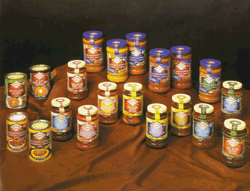
Once considered ethnic foods, Italian, Mexican and Chinese offerings have all seen change in recent years. No longer simply spaghetti and meatballs, Italian food now is more defined. For many, plain olive oil will not suffice, as the preference is extra virgin olive oil from Tuscany.
That is just the beginning of the focus demanded by more consumers. Not long ago, food from Southeast Asia would have been grouped under the "Oriental" label. Today, consumers are seeking foods from individual countries--Japan, Korea, Malaysia, Thailand or Vietnam. Simply defining a meal as Chinese is not specific enough, as styles of Chinese have grown to include Shanghai (i.e., cabbage and pork), Cantonese (i.e., seafood and fresh vegetables), Szechwan and Hunan.
Those definitions have also led consumers to seek authentic ingredients for their homemade meals. B.J. Jajj, an owner/manager of a Toronto supermarket specializing in East Indian products, notes, "People want authentic products. Products like curry powder can be mixed in Canada, but the formula for blending the mixture is not what people are used to. People come in asking for a certain brand, because that's the taste they're used to."

Familiarity Breeds Contentment
Reasons for the growing diversity in ethnic cuisines are as varied as the foods themselves. One explanation is the increased number of immigrants in the U.S. The popularity of Indian food serves as an example of the power immigration is wielding in restaurants and grocery aisles. In 1998, India was the third-largest supplier of immigrants to the U.S., which saw 498,309 new residents from India between 1981 and 1996, according to statistics from the Immigration and Naturalization Service (INS). In that time, U.S. consumer awareness of Indian cuisine jumped to 74%.Caribbean cuisine has also seen its popularity grow in recent years. Not coincidentally, the Dominican Republic, Cuba, Jamaica and Haiti were among the top 11 countries of origin for immigrants in 1998, according to INS numbers. Statistics show more than 394,000 Caribbean immigrants entered the U.S. between 1995 and 1998. The U.S. Census Bureau says 9.9% of the U.S. foreign-born population is from the Caribbean, while as a whole Latin America accounts for 51% of the total foreign-born population.
The growing popularity of Caribbean foods is evident in the success of Bahama Breeze restaurants, a division of Darden Restaurants. According to Rick Walsh, senior vice president of corporate affairs with Darden, the Caribbean-themed restaurants extend the idea of fusion foods, mixing foods of different ethnic backgrounds.
"Think about the Caribbean. It's a cultural crossroads. Influences are Dutch, Portuguese, African, Mexican. It appeals to a broad demographic."
The chain is quick to note its influence, however. Rick Crossland, senior vice president of culinary and beverage development with Bahama Breeze, says, "I would characterize our food as contemporary Caribbean cuisinetruly authentic dishes like jerks and Creole and that sort, but in addition, mainstream proteins from the U.S. with a tropical twist."
Among restaurants around the country, that "twist" is not relegated to only Caribbean influences. According to "Ethnic Cuisines II," a study by the National Restaurant Assoc., Italian, Mexican and Cantonese-Chinese foods have "become adapted to such an extent that 'authenticity' is no longer a concern for customers. In fact, they are so well known that most non-ethnic restaurants offer a variety of dishes from these regions on their menus." More than 90% of consumers were familiar with or had tried these foods, with about half eating them frequently. Perhaps more surprising, German, French, Greek, Indian, Japanese, Scandinavian, Spanish and variations of Chinese (Hunan, Szechwan and Mandarin) were known among 70% to 80% of consumers.
"Consumers are finding and trying more and more cuisine options than ever," said Steven C. Anderson, president and chief executive officer of the National Restaurant Assoc. "The traditional ethnic cuisines Americans have been eating for years, while still popular, are not the only show in town. Cuisines such as Latin American, Korean and Mediterranean are becoming more recognized by consumers, and this trend toward Americans experimenting with cuisines that are foreign to them is likely to continue."

Money Matters
The growing acceptance of ethnic foods can also be attributed to a successful economy. With more disposable income, consumers are willing to experiment with different cooking techniques, ingredients and styles. Patrons are willing to try different, perhaps more expensive restaurants, which have been expanding their menus to accommodate a growing variety of tastes.Restaurants have long been a proving ground for foods, ingredients and cuisines, a trend which does not appear to be losing any effectiveness. Some chefs, in fact, are showcasing lesser-known Asian vegetables, such as ong choy, choy sum and dau mui.
As Marc Murphy, chef/owner of New York's Chinoisserie, says, "These vegetables were around 15 years ago, but they weren't as available as today."
"Today, so many people are looking for something different," according to Makoto Tanaka, chef/owner of Beverly Hills, Calif.'s Mako. "There are so many different kinds of Asian vegetables."
"I'm always looking for something that's new and exciting," comments Scott Serpas of Sia's in Atlanta. "People today are pretty well traveled, or they're open to trying different things."
Travel has played a key role
In the growing acceptance of newer ethnic foods, and more disposable income has also led more Americans to travel overseas to experience the wonders and foods of other countries. Some 56.3 million U.S. residents traveled internationally in 1998, according to the U.S. Department of Commerce, International Trade Administration, Tourism Industries Office, and the number of such travelers has grown every year since 1992. Upon their return, many of these travelers find foods are an excellent means of reliving an enjoyable journey.A New Age
Generations X and Y (ages 18 to 34) deserve some credit for the growth of ethnic cuisines. Many experts consider this age group adventurous, and that could well be reflected in their food choices. However, another possibility for their diverse palates could be their exposure to a variety of ethnic cuisines at a young age. Dining at a variety of restaurants, due to the busy schedules of their multitasking parents, this group does not consider eating unfamiliar foods to be experimentation.Another school of thought emerges when looking at age as a factor in the growing popularity of ethnic cuisine--particularly those with a spicier kick. According to the California Restaurant Assoc., as baby boomers age, their taste buds are becoming less sensitive, and they crave hotter, more flavorful food. As such, the group expects restaurants will target boomers with spicy cheeses, chicken wings, salsa and sausages.
The growing number of spices in America's restaurants was addressed at Morningstar Farms' "Focus on Flavor 2000," where participants noted the top spices likely to influence American meals. Among them were red pepper, dill, cumin, cinnamon, ginger, vanilla, basil, rosemary, thyme and fennel. Further, the chefs provided a flavor forecast for the future, predicting growth in items from the Caribbean, a blending of Caribbean and Hispanic flavors, and a growing influence from Latin American, Indian, and Hawaiian/Polynesian cuisine.
The Health It Is
The desire for healthier, yet flavorful cuisine stands as another factor in the growth of ethnic foods. Many Americans' quest for lowfat and low-salt fare is no reflection of a desire for bland cuisine, and the variety of spices and flavors in many ethnic items is fueling an interest among health-conscious individuals. Vegetarians, in fact, have displayed quite an acceptance for the flavors in ethnic cuisines. A poll by People for the Ethical Treatment of Animals found 24% of respondents were influenced by Italian cuisine, with 18% reporting an influence from Indian and Mexican foods. Some 17% enjoyed Chinese fare, while 13% reported a taste for Thai food.The growth in Thai food expands beyond the vegetarian category, as 68% of all Americans are aware of this ethnic cuisine, according to "Ethnic Cuisines II." The impact of Thai food is being felt among American chefs as well. Su-Mei Yu, of Houston's Sur La Table and author of Cracking the Coconut, notes the impact of Thai food upon American chefs.
"American chefs are discovering exotic ingredients, such as chilies, kaffir lime leaves, lemongrass, fresh tumeric and galangal (Thai ginger). I think this is going to change the way we cook and eat in this country, especially as more people start to use these ingredients to add a surprising punch to their food. (Diners) are much more adventurous. Things like dried shrimp no longer faze them. . . Foods with intriguing, strange names no longer scare them. They'll eat anything you put out, and they want things hot, very hot. We've sold more chili peppers (in 2000) than we've sold in the past couple of years. Our order for chili peppers went up 200%."
The popularity of ethnic foods shows no signs of waning. Kraft Foods, in fact, seems certain the acceptance will continue and has made an equity investment in EthnicGrocer.com. In addition, the company has a staff devoted to developing products to tempt the palates of consumers craving Asian cuisine, and numerous other food companies have dedicated resources to expanding the offerings available to consumers, including Hormel (with its Patak's brand), Pillsbury (Old El Paso) and Goya.
